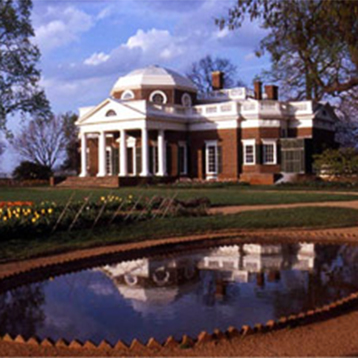Monticello, near Charlottesville, Virginia
Monticello, located near Charlottesville, Virginia, was the estate of Thomas Jefferson, author of the United States Declaration of Independence, the third President of the United States, and founder of the University of Virginia. The house, the center of a plantation of 5,000 acres, is of Jefferson's own design and is situated on the summit of an 850-foot-high peak. Its name appropriately coined, means "little mountain" in Italian. The home, is the remarkable integration of Jefferson’s love of classical architecture and his passion for what were at the time, modern innovations. The latter included louvered Venetian enclosures on the south side of the house, dumbwaiters and double-acting glass –paneled doors into the parlor.
Construction began in 1769 according to Jefferson's first neoclassical design, which was basically completed when he left for Europe in 1784. As a result of Jefferson’s extended travels in Europe, he expanded his vision for Monticello to incorporate features of Palladian buildings and ruins he admired overseas. Further work on the new design began in 1796 and construction of Monticello was substantially completed in 1809 with the erection of the dome.
The original main entrance is through the portico on the east front. The west front gives the impression of a villa of very modest proportions, with a lower floor disguised in the hillside. The south wing includes Jefferson's private suite of rooms. Its library holds many books from Jefferson’s collection. The north wing includes the dining room and two guest bedrooms.
Monticello was designated a World Heritage Site in 1987. In 2001, the Pritzker Architecture Prize ceremony honoring the Swiss team of architects Herzog and de Meuron was held at Monticello. The ceremony and dinner took place on the grounds adjacent to Jefferson’s house.
